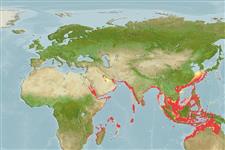Environment: milieu / climate zone / depth range / distribution range
Ecologia
marinhas demersal; intervalo de profundidade 20 - 240 m (Ref. 89707). Tropical; 33°N - 23°S, 35°W - 143°E (Ref. 5222)
Indo-West Pacific: Red Sea, Persian Gulf, Gulf of Oman, Pakistan, India, Viet Nam, Hong Kong, China, Korea, southern Japan, Taiwan, and northwest Australia. Unknown from the east coast of Africa, islands of the Indian Ocean, Indonesia, Philippines, or New Guinea.
Comprimento de primeira maturação / Tamanho / Peso / Idade
Maturity: Lm ?, range 86 - ? cm
Max length : 137 cm SL macho/indeterminado; (Ref. 4787); common length : 70.0 cm TL macho/indeterminado; (Ref. 5450); peso máx. publicado: 58.6 kg (Ref. 4787)
Espinhos dorsais (total) : 11; Raios dorsais (total) : 12 - 14; Espinhos anais: 3; Raios anais : 8. Distinguished by the following characteristics: juveniles are lavender-grey or pale brownish, shading to white ventrally; 2 black-edged white longitudinal bands, upper band extending from above the eye to the anterior dorsal-fin rays, and the lower band from below the eye to the lower band from below the eye to the lower caudal-fin rays; black spots and streaks on dorsal and caudal fins; head and body of large adults, uniformly grey; body depth contained 2.9-3.4 times in SL; head length 2.3-2.6 times in SL; convex interorbital area, convex dorsal head profile; angular preopercle, 3-7 distinctly enlarged serrae at angle; distinctly convex upper edge of operculum; subequal anterior and posterior nostrils; maxilla reaches past vertical at rear edge of eye; 2-3 rows of teeth on midlateral part of lower jaw (Ref. 89707).
Seems to prefer continental localities; bottoms of low relief. Large individuals are taken on coarse sand or rocky areas, while the smaller ones live on silty-sand and muddy bottom. Also caught throughout the year by long-liners (Ref. 5222).
Ciclo de vida ou comportamento de acasalamento
Maturidade | Reprodução | Desova | Ovos | Fecundidade | Larvas
Heemstra, P.C. and J.E. Randall, 1993. FAO Species Catalogue. Vol. 16. Groupers of the world (family Serranidae, subfamily Epinephelinae). An annotated and illustrated catalogue of the grouper, rockcod, hind, coral grouper and lyretail species known to date. Rome: FAO. FAO Fish. Synop. 125(16):382 p. (Ref. 5222)
Status na Lista Vermelha da UICN (Ref. 130435: Version 2024-2)
Ameaça para os humanos
Harmless
Uso pelos humanos
Pescarias: espécies comerciais
Ferramentas
Relatórios especiais
Baixar XML
Fontes da internet
Estimates based on models
Preferred temperature (Ref.
123201): 19.5 - 28.2, mean 26 °C (based on 902 cells).
Índice de diversidade filogenética (Ref.
82804): PD
50 = 0.5000 [Uniqueness, from 0.5 = low to 2.0 = high].
Bayesian length-weight: a=0.01230 (0.00773 - 0.01958), b=3.04 (2.91 - 3.17), in cm total length, based on LWR estimates for this species & Genus-body shape (Ref.
93245).
Nível Trófico (Ref.
69278): 4.0 ±0.65 se; based on food items.
Generation time: 11.0 ( na - na) years. Estimated as median ln(3)/K based on 2
growth studies.
Resiliência (Ref.
120179): Baixo, tempo mínimo de duplicação da população 4,5 - 14 anos (tmax=30).
Fishing Vulnerability (Ref.
59153): Very high vulnerability (77 of 100).
Nutrients (Ref.
124155): Calcium = 54.2 [22.6, 119.0] mg/100g; Iron = 0.854 [0.376, 2.031] mg/100g; Protein = 18.1 [16.5, 19.6] %; Omega3 = 0.206 [0.104, 0.397] g/100g; Selenium = 97.8 [46.3, 245.2] μg/100g; VitaminA = 21 [5, 85] μg/100g; Zinc = 0.873 [0.536, 1.456] mg/100g (wet weight);
